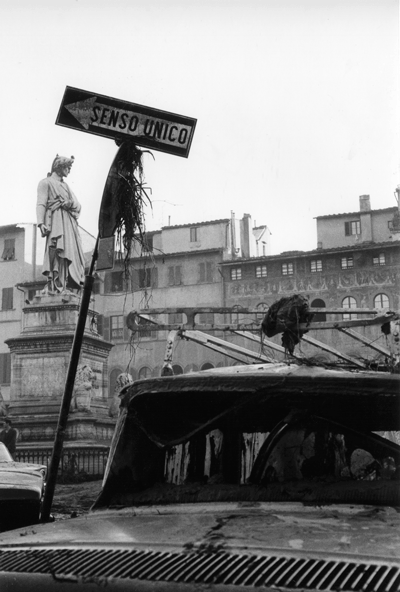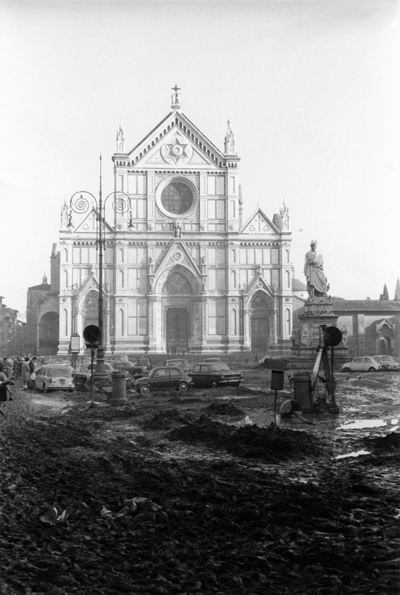A Tuscan Series By Paul Salsini |
A sweeping narrative from World War II to the turbulent 1990s |
The Flood of Florence, November 4, 1966

The statue of Dante looking down at the wreckage in the Piazza Santa Croce the day after the flood. Photo by Swietlan Nicholas Kraczyna.
Like other rivers that descend from mountains, the Arno begins as a simple little stream. At its start, it seeps out of Monte Falterona, far into the Castentine Forests about twenty-five miles east of Florence. The mountain is thought to be named for an ancient god who lived deep inside. For centuries, people in the area believed that if an earthquake awakened the god, they would all be drowned. The Etruscans, in fact, threw thousands of small bronze statues, depicting people and animals, into a lake, called Lake of the Idols, to keep the god happy.
Rushing down the mountainside, the Arno gathers size and strength and sweeps southeast near Arezzo, then turns west, flowing through the heart of Florence. Then it rushes on to Empoli and finally through Pisa, where it empties into the Ligurian Sea.
But before all that, there is a lake at Monte Falterona near the source of the Arno. It is called Gorga Nera, or "black throat." Some people believe that it is bottomless and that one can hear mighty rumbles that can cause landslides and earthquakes. And floods.
In 1966, heavy rains began falling in Tuscany in September. Soon, the Castentine area was saturated. The rains increased in October and November, and on November 2 alone, seventeen inches of rain fell in twenty-four hours on Monte Falterona. The snow on the mountain melted, and slushy rivers headed toward Florence.
At 2.30 p.m. on Thursday, November 3, 1966, the Civil Engineering Department in Florence declared that there was "an exceptional quantity of water" and the city's drains were unable to cope. Suddenly, manhole covers popped off and powerful jets gushed in the air. Basements flooded around the Santa Croce and San Frediano areas. The first electricity failures were reported as fuses began to blow.
Surrounded by twenty-five foot walls, the Arno did not seem likely to burst through its banks in Florence, however.
North of Florence, floodwaters poured over roads and bridges, cutting off the little villages and forcing people to the roofs of their homes. At the aqueduct, a workman named Carlo Maggiorelli, fifty-two years old, had arrived at 8 o'clock Thursday night, carrying a thermos of coffee, half a loaf of bread and a pack of cigarettes. In a telephone call to officials in Florence, he reported that "everything's going under." But he refused to leave; he was responsible for the plant. Later, his body was recovered in a tunnel choked with mud. He was the first victim of the flood of November 4, 1966.

Piazza Santa Croce after the flood. Photo by Swietlan Nicholas Kraczyna.
The dam at La Penna and, farther south, the one at Levane, overflowed throughout the night of November 3. When the gates at La Penna were finally opened, they released more water than the dam at Levane could handle, and water poured down into the valley above Florence and then, racing at thirty-seven miles an hour, toward the city itself.
Florence's newspaper, La Nazione, was in a building opened only a month before the flood and it contained some of the most advanced printing equipment in Europe. On Thursday night, the staff went to work preparing the paper for the following morning. It was printed before the basement presses were flooded, and it appeared on the streets at 7 a.m.: "L'Arno Straripa a Firenze." "The Arno overflows at Florence."
The article went on to report: "The city is in danger of being flooded. At 5:30 this morning water streamed over the embankments, flooding the Via dei Bardi, the Borgo San Jacopo, the Volta dei Tintori and the Corso dei Tintori, the Lungarno delle Grazie and the Lungarno Acciaiuoli. Many families are evacuating their homes. The river banks at Rovezzano and Compiobbi were overtopped shortly after 1 a.m. The Via Villamagna and the aqueduct plant at Anconella were invaded a short time later, and certain areas of the city are in danger of losing their water supply. There are indications that the day ahead may bring drama unparalleled in the history of the city. At 4:30 a.m. military units were ordered to stand by to cope with a possible emergency situation."
After breaching its retaining walls on both sides, the Arno flooded the city on Friday. On the north side, it swept through the National Library, the Piazza Santa Croce and the church itself. Then it roared on to the Piazza della Signoria, covering the spot where Savonarola was burned to death, and on to Dante's House, the Uffizi, Palazzo Vecchio and the Badia. By 9:35 a.m. it reached the Duomo and the Campanile, where it tore off the precious panels from the Baptistry and flooded the church itself. Then on to the neighborhoods of Santa Maggiore and the Medici Chapel and San Lorenzo and Santa Maria Novella and San Paolino and on and on and on. At the Accademia, water inched up toward the David and the Unfinished Statues.
On the south side, in the Oltrarno, waters rushed past San Jacopo Sopr'Arno, Palazzo Guicciardini, the Palazzo Pitti, Santo Spirito and Borgo San Frediano. Florence had become an immense lake of water, mud and fuel oil covering, according to one estimate, more than seven thousand acres. The bridges connecting the two sides were impassable, turning Florence into two cities. Plaques that recorded the height of previous floods were quickly covered with water and oil. In the Piazza Santa Croce, the water reached more than twenty-two feet, more than twice as high as the flood of 1557.
At nightfall, thousands of people were stranded on rooftops, waiting, often in vain, for rescue from helicopters. One elderly woman lost her grip and fell to her death.
Observing how the flood had ruined the lives of the poor of Florence, the writer Carlo Coccioli wrote in the newspaper Il Giorno, "At the thought of the suffering inflicted upon the lives of those humble folk, my supposed understanding of God's will evaporated."
Records after the flood estimated that 1,500 works of art in Florence were disfigured or destroyed. Of these, 850 were seriously damaged, including paintings on wood and on canvas, frescoes and sculptures. Among the casualties were Paolo Uccello's Creation and Fall at Santa Maria Novella, Sandro Botticelli's Saint Augustine and Domenico Ghirlandaio's Saint Jerome at the Church of the Ognissanti, Andrea di Bonaiuto's The Church Militant and Triumphant at Santa Maria Novella, Donatello's wooden statue of Mary Magdalene in the Baptisty of the Duomo, Baccio Bandinelli's white marble Pietà in Santa Croce and Filippo Brunelleschi's wooden model for the cupola of the Duomo, in the Duomo's Museum. Three panels were torn from Lorenzo Ghiberti's Gate of Paradise on the east side of the Baptistry and two from Andrea Pisano's panels on the south.
The greatest loss was the Crucifixion by Giovanni Cimabue, the Father of Florentine Painting, in the Santa Croce Museum. The water there rose thirteen feet and the painting was ruined.
At the National Library, the flood damaged 1,300,000 items, including the majority of the works in the Palatine and Magiabechi collections, along with periodicals, newspapers, prints, maps and posters. This was a third of the library's collections.
There was also extensive damage to the collections at the Opera del Duomo, the Gabinetto Vieusseux Library and the State Archives.
But more than all the art that was ruined, this was a personal tragedy that touched the lives of every Florentine. Twenty thousand families lost their homes, fifteen thousand cars were destroyed, and six thousand shops went out of business. At least thirty people died; some reports put the toll at more than a hundred.